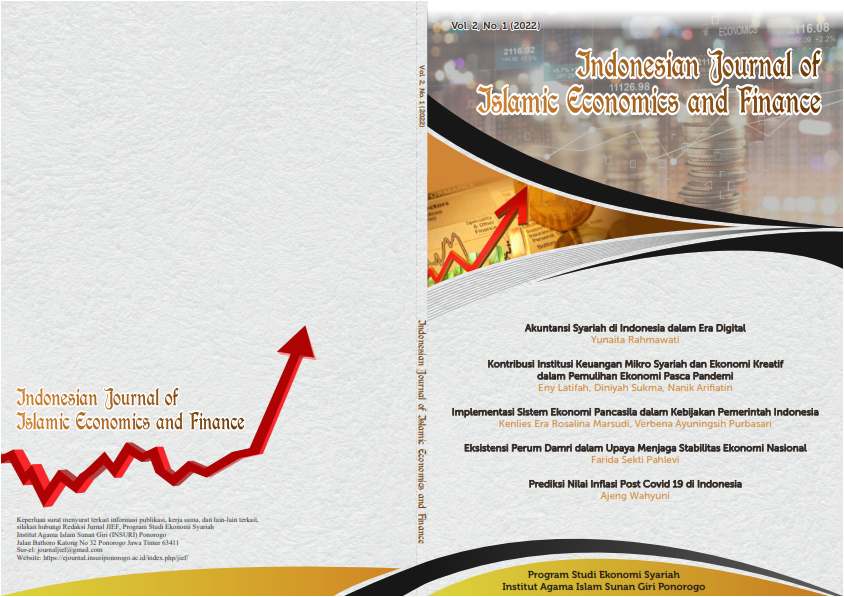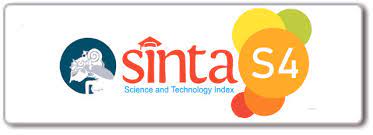Prediksi Nilai Inflasi Post Covid 19 di Indonesia
DOI:
https://doi.org/10.37680/ijief.v2i1.1606Keywords:
Inflation, Post covid-19, ARIMA, ForecastingAbstract
The COVID-19 pandemic has positively impacted inflation in Indonesia, where inflation decreased to 1.33 in June 2021. It would be better if Indonesia could maintain this figure, but in July 2021, the inflation rate began to rise again; even in April 2022, the inflation rate reached 3.47. This study will predict the inflation value after the covid-19 pandemic using Autoregressive Moving Average (ARIMA) analysis. Using monthly time-series data, we study inflation in Indonesia during the period 2010 – 2022, then predict the inflation value in the following months using Autoregressive Moving Average (ARIMA) analysis. The data is stationary at the first difference. Several possible ARIMA models analyzed show that the ARIMA (1,1,1) model was chosen as the best model. The results of this study indicate that monthly inflation in Indonesia is likely to continue to rise. The government is expected to make appropriate policies to reduce inflation based on these results.
References
Badan Pusat Statistik. (2020). Berita Resmi Statistik: Perkembangan Indeks Harga Konsumen/Inflasi. 4 Mei 2020.
Bank Indonesia. (n.d.). Apa Itu Inflasi. https://www.bi.go.id/id/fungsi-utama/moneter/inflasi/default.aspx#floating-2
Box, G. E. P., & Jenkins, J. (1970). Time Series Analysis, Forecasting, and Control.
Friawan, D., & Kurnia, Y. E. (2021). Pandemi Covid-19 dan Ancaman Inflasi di Indonesia? CSIS Commentaries, CSIS Comme (September), 1–11.
Ghozali, I. (2009). Ekonometrika: teori, konsep dan aplikasi dengan SPSS 17. Semarang: Badan Penerbit Universitas Diponegoro, 50.
Habarier, G. (1960). Inflation, Its Cause ad Cures. America Enterprise Association.
Hendriana, Y. (2021). Inflasi dan Mobilitas Masyarakat di Masa Pandemi Covid-19. Jurnal Akuntansi Dan Ekonomika, 11(2), 150–158. https://doi.org/10.37859/jae.v11i2.2831
Mankiw, N. G. (2018). Principles of Economics (8th Editio). Cangage Learning.
Mutwiri, N. M. (2017). Monetary Policy Tools and Inflation in Kenya. International Journal in Academic Research in Accounting, Finance and Management Sciences, 7(1), 86–97.
Priyadi, A., Susamto, A. A., & Purwoto, H. (2021). Dampak COVID-19 Terhadap Tingkat Inflasi Indonesia.
Review, T. N.-D., & 2018, undefined. (n.d.). Modeling and forecasting inflation in Kenya: Recent insights from ARIMA and GARCH analysis. Researchgate.Net. Retrieved June 29, 2022, from https://www.researchgate.net/profile/Thabani-Nyoni/publication/329315962_MODELING_AND_FORECASTING_INFLATION_IN_KENYA_RECENT_INSIGHTS_FROM_ARIMA_AND_GARCH_ANALYSIS/links/5c012a27299bf1a3c156cb8f/MODELING-AND-FORECASTING-INFLATION-IN-KENYA-RECENT-INSIGHTS-FROM-ARIMA-AND-GARCH-ANALYSIS.pdf
Salam, W. R. (2020). Inflasi di Tengah Pandemi dalam Perspektif Islam. Jurnal Syntax Tranformation, 1(5), 1–9.
Yuniarti, D., Rosadi, D., & Abdurakhman. (2021). Inflation of Indonesia during the COVID-19 pandemic. Journal of Physics: Conference Series, 1821(1). https://doi.org/10.1088/1742-6596/1821/1/012039
Downloads
Published
How to Cite
Issue
Section
License
Copyright:
An author who publishes in Indonesian Journal of Islamic Ekonomics and Finance agrees to the following terms:
- Author retains the copyright and grants the journal the right of first publication of the work simultaneously licensed under a Creative Commons Attribution-NonCommercial 4.0 International License that allows others to share the work with an acknowledgment of the work's authorship and initial publication in this journal.
- Author is able to enter into separate, additional contractual arrangements for the non-exclusive distribution of the journal's published version of the work (e.g., post it to an institutional repository or publish it in a book) with the acknowledgment of its initial publication in this journal.
- Author is permitted and encouraged to post his/her work online (e.g., in institutional repositories or on their website) prior to and during the submission process, as it can lead to productive exchanges, as well as earlier and greater citation of the published work (See The Effect of Open Access).
License:
-
Attribution — You must give appropriate credit, provide a link to the license, and indicate if changes were made. You may do so in any reasonable manner, but not in any way that suggests the licensor endorses you or your use.
-
NonCommercial — You may not use the material for commercial purposes.
-
No additional restrictions — You may not apply legal terms or technological measures that legally restrict others from doing anything the license permits.
You are free to:
- Share — copy and redistribute the material in any medium or format
- Adapt — remix, transform, and build upon the material

This work is licensed under a Creative Commons Attribution-NonCommercial 4.0 International License.



.png)







